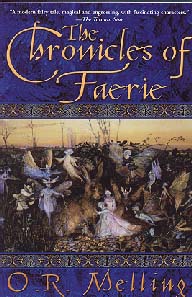| ________________
CM . . .
. Volume X Number 8. . . . December
12, 2003
excerpt:
Any adult and student fantasy fans unfamiliar with the works of O.R. Melling are in for a delightful literary experience when they pick up The Chronicles of Faerie, a new one volume compilation of previously published works: The Hunter's Moon, The Summer King and The Light-Bearer's Daughter. Melling's Faerie world is a distant cry from J.K. Rowling's world of muggles and magic folk or J.R.R. Tolkien's hobbits and wizards where the forces of good and evil are delineated. Heroes and heroines can follow their conscience because their moral duties are clear. Instead, Melling remains truer to the time honored traditions of Irish mythology in which layers of beautiful gossamer veils obscure truth and the faerie folk's motives often lie deep in their immortal past. In each of the books, Melling's young heroines are drawn deep into the faerie world and soon find themselves in deadly situations. Although the weakest of the books in story and style, The Hunter's Moon still admirably sets the stage for the increasingly complex stories that are developed in the subsequent chronicles. Gwen, a young Canadian, and her Irish cousin, Findabhair, are enamored by tales of faeries. They try to make contact, and the King of the Faeries abducts the beautiful Findabhair, who is made Queen of the Faeries. Aided by mysteriously helpful faerie folk, Gwen travels the width and breadth of Ireland in search of her cousin, who, it turns out, is to become a human sacrifice to save the Faerie world from destruction. Although it first seemed to Gwen that the Faeries treated them as playthings or pawns, she learns that these events did not happen by chance, nor did they occur because the girls sought out the faeries, nor did they occur by faerie whim or malicious nature. Gwen sees an intertwining of human and faerie lives which exists to keep the natural order of the world in its precarious balance. Now it seems that she, and we, might understand the meaning of W.B. Yeats poem, "The Stolen Child," quoted in the book's frontispiece:
Highly Recommended. Ian Stewart teaches at David Livingstone School in Winnipeg, MB.
To comment
on this title or this review, send mail to cm@umanitoba.ca.
Copyright © the Manitoba Library Association. Reproduction for personal
use is permitted only if this copyright notice is maintained. Any
other reproduction is prohibited without permission.
NEXT REVIEW |TABLE OF CONTENTS FOR THIS ISSUE
- December 12, 2003.
AUTHORS
| TITLES | MEDIA REVIEWS
| PROFILES
| BACK ISSUES
| SEARCH | CMARCHIVE
| HOME |
